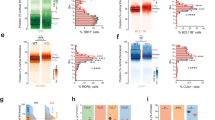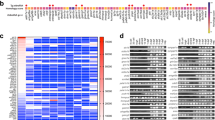Abstract
The morphogenesis of the brain and the differentiation of the neural structures are highly complex processes. A series of temporally and spatially regulated morphogenetic events gives rise to smaller areas that are phylogenetically, functionally and often morphogenetically different1,2. Candidate genes for positional information and differentiation during morphogenesis have been isolated2–5. Both in vivo inactivation in mice6–8 and impairment in human diseases5,9 revealed, that they are required in regional specification and/or correct cell-type induction. We have previously cloned and characterized the murine Otx1 gene3,10, which is related to orthodentide (otd), a homeobox-containing gene required for Drosophila head development11,12. Expression data during murine embryogenesis3,10 and postnatal brain development13 support the idea that Otx1 could be required for correct brain and sense organs development. To decipher its role in vivo we produced null mice by replacing Otd1 with the lacZ gene. Otx1−/− mice showed spontaneous epileptic behaviour and multiple abnormalities affecting mainly the telencephalic temporal and perirhinal areas, the hippocampus, the mesencephalon and the cerebellum, as well as the acoustic and visual sense organs. Our findings indicate that the Otx1 gene product is required for proper brain functions.
This is a preview of subscription content, access via your institution
Access options
Subscribe to this journal
Receive 12 print issues and online access
$209.00 per year
only $17.42 per issue
Buy this article
- Purchase on Springer Link
- Instant access to full article PDF
Prices may be subject to local taxes which are calculated during checkout
Similar content being viewed by others
References
Kuhlenbeck, H. The Central Nervous System. of Vertebrates. (S. Karger, Basel, (1994).
Rubenstein, J.L.R., Martinez, S., Shimamura, K. & Puelles, L. The embryonic vertebrate forebrain: the prosomeric model. Science 266, 578–580 (1994).
Simeone, A., Acampora, D., Gulisano, M., Stomaiuolo, A. & Boncinelli, E. Nested expression domains of four homeobox genes in developing rostral brain. Nature 358, 687–690 (1992).
Davis, C.A. & Joyner, A.L. Expression patterns of the homeobox-containing gene En1 and En2 and the proto-oncogene int-1 during mouse development. Genes Dev. 2, 1736–1744 (1988).
Gruss, P., Walther, C. Pax in development Cell 69, 719–722 (1992).
Acampora, D. et al. Forebrain and midbrain regions are deleted in Otx2−/−mutants due to a defective anterior neuroectoderm specification during gastrulation. Development 121, 3279–3290 (1995).
McMahon, A.P. & Bradley, A., The Wnt-1 (int-1) proto-oncogene is required for development of a large region of the mouse brain. Cell 62, 1073–1085 (1990).
Joyner, A.L., Herrup, K., Auerbach, B.A., Davis, C.A. & Rossant, J. Subtle cerebellar phenotype in mice homozygous for a targeted deletion of the En-2 homeobox. Science 251, 1239–1243 (1991).
Brunelli, S. et al. Germline mutations in the homeobox gene EMX2 in patients with severe schizencephaly. Nature Genet. 12, 94–96 (1996).
Simeone, A. et al. A vertebrate gene related to orthodenticle contains a homeodomain of the bicoid class and demarcates anterior neuroectoderm in the gastrulating mouse embryo. EMBO J. 12, 2735–2747 (1993).
Hirth, F., Therianos, S., Loop, T., Gehring, W.J., Reichert, H. & Furukubo-Tokunaga, K. Developmental defects in brain segmentation caused by mutations of the homeobox genes orthodenticle and empty spiracles in Dmsophila . Neuron 15, 769–778 (1995).
Royet, J. & Finkelstein, R. Pattern formation in Drosophila head development: the role of the orthodenticle homeobox gene. Development 121, 3561–3572 (1995).
Frantz, G.D., Weimann, J.M., Levin, M.E. & McConnell, S.K. Otxl and Otx2 define layers and regions in developing cerebral cortex and cerebellum. J. Neurosci. 14, 5725–5740 (1994).
Haddon, C.M. & Lewis, J.H. Hyaluronan as a propellent for epithelial movement: the development of semiciruclar canals in the inner ear of Xenopus Development 112, 541–550 1991).
Kelly, J.P. Vestibula System. in PrinciplesofNeural Science.2nd edn. (eds Kandel, E.R. & Schwartz, J.H. ) 584 (Elsevier, New York, 1985).
Dichter, M.A. The epilepsies and convulsive disorders in Herrinson's Principles of Internal Medicine. 12th edn. (eds Wilson, J.D. et al) 1968–1977 (McGraw-Hill, New York, 1991).
Commission on: Classification and terminology of the international league against epilepsy. Epilepsia 30, 391–399 (1989).
Meencke, H.J. & Janz, D. Neuropathological findings in primary generalized epilepsy: a study of eight cases. Epilepsia 25, 8–21 (1984).
Raymond, A.A., Fish, D.R., Sisodiya, S.M., Alsanjari, N., Stevens, J.M. & Shorvon, S.D. Abnormalities of gyration, heterotopias, tuberons sclerosis, focal cortical dysplasia, microdysgenesis, dysembryoplastic neuroepithelial tumor and dysgenesis of the archicortex in epilepsy. Clinical, EEG and neuroimaging features in 100 adult patients. Brain 118, 629–660 (1995).
Noebels, J.L. Targeting epilepsy genes. Neuron 16, 241–244 (1996).
Ottman, R. et al. Localization of a gene for partial epilepsy to chromosome 10q. Nature Genet. 10, 56–60 (1995).
Phillips, H.A. et al. Localization of a gene for autosomal dominant nocturnal frontal lobe epilepsy to chromosome 20q13.2. Nature Genet. 10, 117–118 (1995).
Eksioglu, Y.Z. et al. Periventricular heterotopia: An X-linked dominant epilepsy locus causing aberrant cerebral cortical development. Neuron 16, 77–87 (1996).
Matsumoto, M. et al. Ataxia and epileptic seizures in mice lacking type 1 inosrtol 1,4,5-triphosphate receptor . Nature 379, 168–171 (1996).
Le Mouellic, H., Lallemand, Y. & Brulet, P. Targeted replacement of the homeobox gene Hox-3.1. by the Escherichia coli lacZ in mouse chimeric embryos. Proc. Natl. Acad. Sci. USA 87, 4712–4716 (1990).
Robertson, E.J. Embryo-derived stem cell lines, in Teratocarcinomas and Embryonic Stem Cells. A Practical Approach, (ed. Robertson, E.J.) 71–112 (IRL, Oxford, (1987).
Hogan, B., Beddington, R., Costantini, F. & Lacy, E. Manipulating the Mouse Embryo. A laboratory manual. 2nd edn. (Cold Spring Harbor Laboratory Press, Cold Spring Harbor, New York, (1994).
Paxinos, G. & Watson, C. The Rat Brain in Stereotaxic Coordinates. 2nd edn. (Academic Press, Australia, (1986).
Author information
Authors and Affiliations
Rights and permissions
About this article
Cite this article
Acampora, D., Mazan, S., Avantaggiato, V. et al. Epilepsy and brain abnormalities in mice lacking the Otx1 gene. Nat Genet 14, 218–222 (1996). https://doi.org/10.1038/ng1096-218
Received:
Accepted:
Issue Date:
DOI: https://doi.org/10.1038/ng1096-218
This article is cited by
-
Prenatal androgen exposure causes a sexually dimorphic transgenerational increase in offspring susceptibility to anxiety disorders
Translational Psychiatry (2021)
-
Expanding the phenotype of the X-linked BCOR microphthalmia syndromes
Human Genetics (2019)
-
A Study of Effect of Consanguinity on Cochlear Morphology in Patients with Congenital Bilateral Profound Sensorineural Hearing Loss
Indian Journal of Otolaryngology and Head & Neck Surgery (2017)
-
The Nanoscale Observation of the Three-Dimensional Structures of Neurosynapses, Membranous Conjunctions Between Cultured Hippocampal Neurons and Their Significance in the Development of Epilepsy
Molecular Neurobiology (2016)
-
OTX1 expression in breast cancer is regulated by p53
Oncogene (2011)



